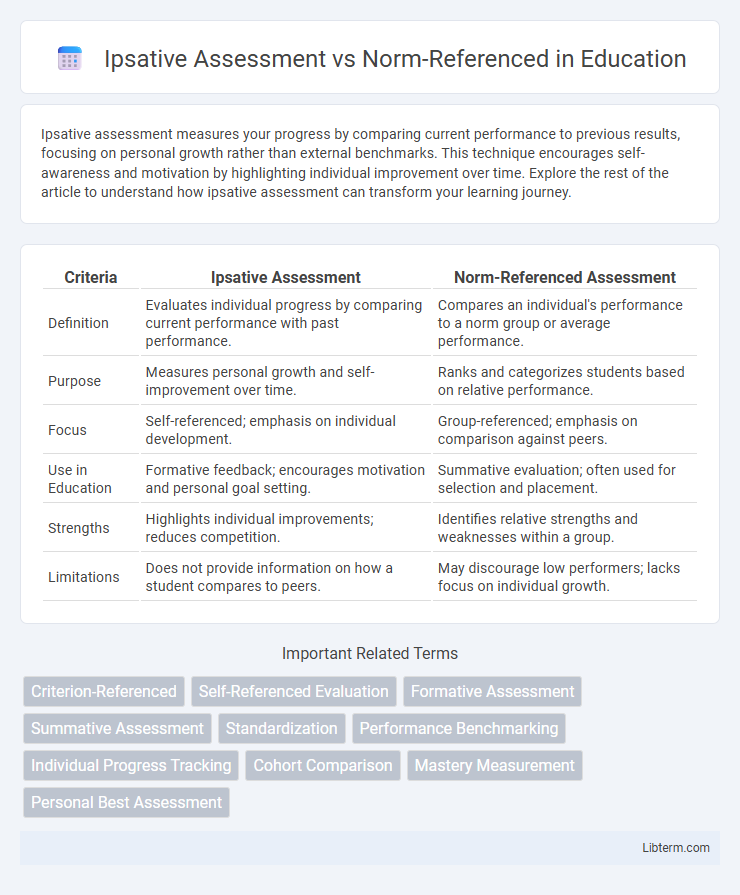Ipsative assessment measures your progress by comparing current performance to previous results, focusing on personal growth rather than external benchmarks. This technique encourages self-awareness and motivation by highlighting individual improvement over time. Explore the rest of the article to understand how ipsative assessment can transform your learning journey.
Table of Comparison
| Criteria | Ipsative Assessment | Norm-Referenced Assessment |
|---|---|---|
| Definition | Evaluates individual progress by comparing current performance with past performance. | Compares an individual's performance to a norm group or average performance. |
| Purpose | Measures personal growth and self-improvement over time. | Ranks and categorizes students based on relative performance. |
| Focus | Self-referenced; emphasis on individual development. | Group-referenced; emphasis on comparison against peers. |
| Use in Education | Formative feedback; encourages motivation and personal goal setting. | Summative evaluation; often used for selection and placement. |
| Strengths | Highlights individual improvements; reduces competition. | Identifies relative strengths and weaknesses within a group. |
| Limitations | Does not provide information on how a student compares to peers. | May discourage low performers; lacks focus on individual growth. |
Introduction to Ipsative and Norm-Referenced Assessment
Ipsative assessment measures a learner's current performance against their previous achievements, emphasizing personal growth and self-improvement. Norm-referenced assessment compares an individual's performance to a broader population, ranking students relative to their peers. Understanding these distinct evaluation methods helps educators tailor instruction and accurately interpret student progress.
Defining Ipsative Assessment
Ipsative assessment measures a learner's progress by comparing their current performance against their previous achievements, emphasizing personal growth and self-improvement. In contrast, norm-referenced assessment ranks individuals by comparing their performance to a broader group, highlighting relative standing. Ipsative evaluation fosters intrinsic motivation by focusing on individual development rather than external benchmarks.
Understanding Norm-Referenced Assessment
Norm-referenced assessment measures a student's performance relative to a defined population, providing percentile ranks and comparative data that help identify strengths and weaknesses. This type of assessment is essential for standardized testing environments, enabling educators to gauge where a learner stands in relation to peers. Norm-referenced results inform decisions on placement, eligibility for special programs, and overall academic benchmarking.
Key Differences Between Ipsative and Norm-Referenced Approaches
Ipsative assessment evaluates an individual's current performance against their previous results, emphasizing personal growth and self-improvement, whereas norm-referenced assessment compares a person's performance to a broader population or group, highlighting relative standing. Ipsative approaches prioritize individual progress and self-development, making them ideal for tracking personal learning trajectories, while norm-referenced methods are designed for comparative ranking and benchmarking against external standards. These key differences influence the choice of assessment based on the goal--personalized feedback versus competitive evaluation within a defined peer group.
Advantages of Ipsative Assessment in Education
Ipsative assessment provides personalized feedback by comparing a student's current performance to their previous achievements, promoting continuous self-improvement and motivation. It reduces anxiety and competition among peers by focusing on individual growth rather than norm-referenced rankings. This approach fosters intrinsic motivation and a deeper understanding of personal learning progress, enhancing long-term educational outcomes.
Benefits of Norm-Referenced Assessment for Comparison
Norm-referenced assessment provides a clear benchmark by comparing an individual's performance against a broader population, enabling educators to identify relative strengths and weaknesses efficiently. It allows for standardized ranking and placement decisions across diverse groups, supporting college admissions, scholarships, and competitive evaluations. This comparative approach facilitates targeted interventions and resource allocation based on percentile ranks and normative data distributions.
Challenges and Limitations of Ipsative Assessment
Ipsative assessment presents challenges such as difficulty in benchmarking learner progress against external standards, limiting its effectiveness in comparative analysis. It may also cause motivation issues, as repeated self-comparisons can lead to frustration or complacency without clear reference points. Moreover, its subjective nature can reduce reliability and complicate aggregate data interpretation for educational stakeholders.
Drawbacks and Criticisms of Norm-Referenced Assessment
Norm-referenced assessment often faces criticism for promoting competition over individual learning by ranking students rather than measuring personal growth or mastery. This system can neglect diverse learning styles and unfairly disadvantage students from varied socio-economic backgrounds, thereby limiting educational equity. Moreover, the emphasis on percentile ranking may encourage teaching to the test rather than fostering comprehensive understanding and critical thinking skills.
Choosing the Right Assessment Method: Factors to Consider
Choosing between ipsative assessment and norm-referenced methods depends on the evaluation goals and context. Ipsative assessment emphasizes individual progress by comparing current performance to past results, ideal for personalized learning and self-improvement tracking. Norm-referenced assessment ranks individuals against a peer group, suitable for high-stakes testing or selection processes where relative performance is critical.
Future Trends in Educational Assessment Methods
Ipsative assessment emphasizes individual progress by comparing a student's current performance to their past achievements, fostering personalized learning paths. Norm-referenced assessment evaluates student performance against a broader population, aiming to rank and categorize learners. Future trends indicate a shift toward integrating ipsative methods with adaptive technologies and data analytics, enhancing personalized feedback while maintaining scalable norm-referenced benchmarks for educational equity and effectiveness.
Ipsative Assessment Infographic

 libterm.com
libterm.com